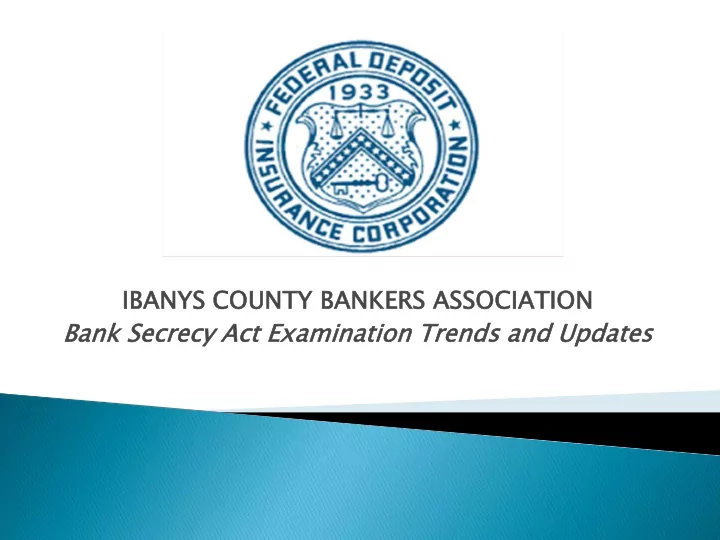

IBANYS COU COUNTY TY B BANKERS ERS ASSOC OCIATI TION Ban ank Secr ecrec ecy A Act ct Ex Exam aminat ation Tr Tren ends an and U Updat ates
Examination Trends Internal Controls Expected Activity Third-Party Oversight (Independent Review) Sharing BSA Resources Marijuana Related Businesses Mergers & Acquisitions
Most common pillar violation cited in the New York Region -326.8(c (c)(1 (1): ): inadequate system of internal controls CDD (ex: risk rating methodology, transaction activity, missing information, higher risk customers, documentation of reviews, and quality control) Expected Activity Collecting vs. Utilizing Third-Party Oversight for Independent Review Ensuring that the third-party scope is appropriate for your institution. Review workpapers to fully understand what was reviewed and if it meets the bank’s expectations.
In October 2018 the Interagency Statement on Sharing Bank Secrecy Act Resources (FI FIL-55 55-201 2018) was issued. Provides guidance to those institutions with collaborative arrangements such as pooling human, technology, or other resources to reduce costs, increase operational efficiencies, and leverage specialized expertise. The collaborative arrangements described in this interagency statement are most suitable for banks with a community focus, less complex operations, and lower-risk profiles for money laundering or terrorist financing. Sharing a BSA Officer may not be appropriate for institutions.
Banks with questions not FinCEN guidance, FI FIN- addressed within the 2014 2014-G001 001, details FinCEN guidance should Bank Secrecy Act contact FinCEN’s compliance Resource Center at: expectations for • 1-800-767-2825 or suspicious activity and • FRC@fincen.gov currency transaction reporting. Per FI FIN-20 2014 14-G001 01, ultimately it is a bank’s choice to open, close, or refuse any particular account or relationship .
If a bank decides to provide services to MRBs, CDD procedures should include: Verify with state authorities whether the business is licensed and registered; Review the state license application and related documentation; Request from state authorities information about the business/related parties; Understand normal and expected activity for the business, including products and the type of customers to be served (medical vs. recreational); Monitor public sources for adverse info about the business/related parties Monitor for suspicious activity (includes red flags); and Refresh CDD information on aperiodic basis and commensurate with the risk.
BSA/AML program should be considered in M&A and business strategy changes. BSA/AML staff should be aware of the types of customers being absorbed and determine if existing systems and staff are appropriate.
FIN IN-2016- A005 was released on October 25, 2016 to assist financial institutions in the following: ◦ Reporting cyber-enabled crime and cyber-events through Suspicious Activity Reports (SARs). ◦ Including relevant and available cyber-related information in SARs; ◦ Collaborating between BSA/Anti-Money Laundering (AML) units and in-house cybersecurity units to identify suspicious activity; and ◦ Sharing information, including cyber-related information, among financial institutions.
Questions??? Brittany ny O O. W Washing ngton n Specia ial A l Activ ivit itie ies Case M Manager bwash ashingt gton@fdic.go gov 917-320-2780
Recommend
More recommend